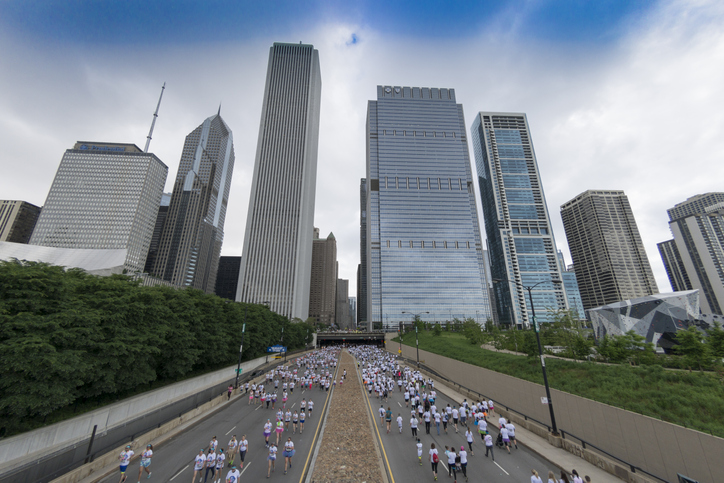
I became a marathoner at the 1993 Chicago Marathon. There were 5,000 participants, the course ran on Lake Shore Drive, and it was so cold and snowy, the Gatorade froze. You never forget your first marathon.
Things have changed since then. There will be about 45,000 participants toeing the line this year, the course will wind through the heart of Chicago’s neighborhoods, and there will be thousands of spectators and volunteers to support the marathoners.
Executive Race Director Carey Pinkowski and his team planted the marathon seed in the Chicago community one person, one business, and one volunteer at a time. The outcome of all their hard work is one of the world’s finest marathons. I asked Carey to share a few tips for first-time Chicago Marathoners and a play-by-play of this year’s course.
What makes the Bank of America Chicago Marathon special?
There’s an amazing convenience factor that adds to the race-day experience when you have a venue like Grant Park that is so accessible. The hotels are within a short walk of the start and finish, spectators can use the CTA public transit system to see participants easily at many different locations on the course, and it is the greatest tour of the city of Chicago.
Any tips for Chicago Marathon newbies?
For a lot of our participants, this is their first marathon or their first big-time race, and there’s so much excitement and energy at the start with the crowds that you have to stay inside yourself to avoid getting caught up in it. You’ve got to keep your focus, concentrate, and conserve your energy to make sure you don’t overreact. There’s a tendency to high five, run a little too fast, and it is easy to get caught up in it. I tell my elite runners the same thing as they too get revved up by the crowd and the enthusiasm. Hold yourself back and save energy.
A Play-by-Play Chicago Marathon Course Strategy:
Break it up into smaller, more digestible checkpoints, like so (course images are courtesy of the Bank of American Chicago Marathon Participant Guide):
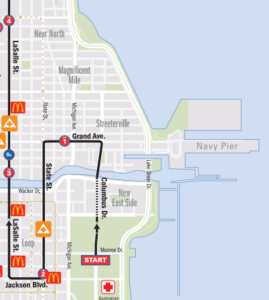
Start line to Mile Four: The Loop
It starts in Grant Park, which is an iconic park and the gem of Chicago. The first few miles are run through the loop on State Street and LaSalle Drive, which is the financial district and the urban center of the city. You’ll see some great architecture. It’s a great time to focus on dialing in your pace and get settled.
For example, if you feel more comfortable taking water with your left hand versus your right, you can give yourself time to set yourself up on that side of the street at the next station. You should be settling in and have an idea of where your pace is. It sets the tone for the rest of the marathon. With a fourth of the race down, you’ll enter Lincoln Park and run past the zoo. You can use all the feedback you’ve gotten so far to make adjustments on your pace and strategy for the race.
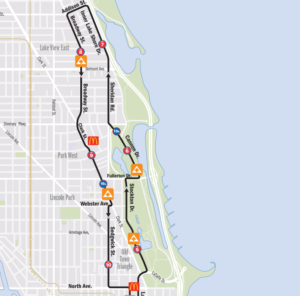
Miles Five to 10: Lincoln Park and Lakeview
By the time you make your way through the start and the loop, you’ll have gone through two aid stations on the course, so you’ll have a sense of what the set up is and what to expect for the next 18 aid stations.
As you move north to Addison, you’ll be able to see Wrigley Field, the farthest northern part of the course. One of the little tricks that I’ve told everyone over the years is, if you look back, you can see the Willis Tower (110 stories). It’s the axis of the course, and you can see it in the northern, western, and southern parts of the course so you always know where the finish line is. You can get a visual of how far you’ve come and how far you need to go. Some people don’t like that, but I’ve heard many say they really like having it as a visual guide.
There’s a lot of energy, excitement, and dancing as you run through this part of the course. Make sure you continue to conserve your energy and avoid the temptation to jump on the curbs and join in the fun.
One of my favorite parts of the course is during miles nine and 10 as you make your way south on Sedgwick and Clark Street. It’s a straight shot, and it’s calming and very scenic with a lot of beautiful brownstones.
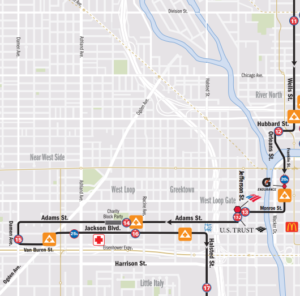
Miles 11 to 17: Old Town, River North, West Loop, Greek Town, and Little Italy
The second half of the course is faster. If you look at our lead athletes, they’ve always run faster in the second half of the course because there aren’t as many turns and there are more straightaways. As you run through Old Town, Greek Town, and the West Loop, you’ll experience some great landmarks and neighborhoods with incredible crowd support.
At the halfway point, you’ll cross back over the river, which will be lined with people ten-deep. It’s quite emotional, and it is the gateway to the second part of the marathon. You’ll head west for miles 13 to 15, then east, south, and west again, making your way through Little Italy. There’s plenty to see and hear, and it’s a big energy boost at that point in the race.
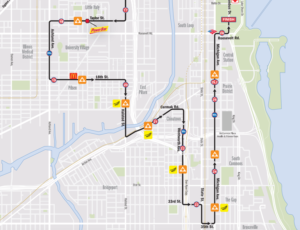
You’ll head right through the heart of the Pilsen, the city’s second-largest Hispanic neighborhood and home to mariachi bands and dancers. As you make your way to the infamous 20-mile mark (The Wall), your mind’s going to try and trick you to try to get you to slow down. This is a great time to keep your mind engaged. Pick a point on the horizon and run to it.
Break it down to counteract the negative thoughts that can slip into your head and start counting down the miles, thinking of familiar routes you’ve trained on. I think of a five-mile run I’ve done hundreds of times, and all I have to do is replicate it in the final miles of the race. Feed yourself with those positive nuggets.
Just past the 23-mile marker, you make the turn onto Michigan Avenue. From here it’s a straight shot to Grant Park and the finish line. Look for the Willis Tower–it will get closer and closer at you make your way. The streets will be lined with cheering volunteers from De LaSalle High School, the Park Forest Running Club, and many other groups.
You’ll know you’re getting very close to the finish when the volume of the crowd intensifies. This is also the point at which you’ll make a quick right turn, then a left, and you’ll see the finish line ahead.



Thank you Jenny! Always full of good advice!
Thank you Charlotte! It is so good to hear from you!
This is perfectly described. Missing you in the Chicagoans area. Thank you for sharing this! Be well!
Thank you Donna! Hope the marathon went well for you!
Thank you Jenny! I’ve read this over and over…..2020 here I come!